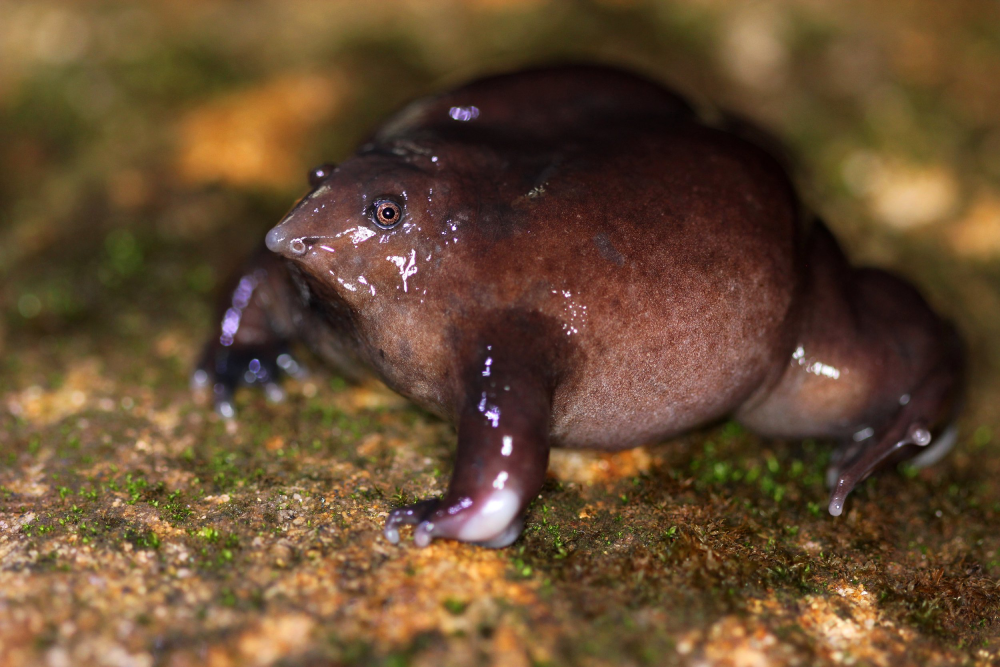In the dense, lush forests of the Western Ghats of India, where biodiversity flourishes in its myriad forms, lies a mysterious creature, seldom seen and barely known to the outside world. This elusive denizen of the undergrowth, the Purple Frog (*Nasikabatrachus sahyadrensis*), is a true marvel of evolution, captivating the imagination of biologists and nature enthusiasts alike.
Unraveling the Mystery of the Purple Frog
The Purple Frog, also known as the “Pignose Frog” or “Doughnut Frog” due to its peculiar appearance, was first discovered in 2003 by scientists S.D. Biju and Franky Bossuyt. Its unique features immediately sparked interest and raised numerous questions within the scientific community. With its plump, purplish body, tiny eyes, and a pointed snout resembling a pig’s nose, this amphibian defies conventional expectations of what a frog should look like.
A Creature of the Dark
What makes the Purple Frog even more enigmatic is its behavior. It is primarily fossorial, spending most of its life underground, emerging only briefly during the monsoon season for breeding. This secretive lifestyle has contributed to its elusiveness and scarcity of sightings. It dwells in burrows it excavates itself, often several feet below the forest floor, emerging only to mate and lay eggs in temporary pools formed by monsoon rains.
Evolutionary Marvel
The Purple Frog’s distinctive appearance and behavior are not just quirks of nature but are finely tuned adaptations honed through millennia of evolution. Its robust body and shovel-like feet are perfectly suited for digging through the soil, allowing it to burrow efficiently and swiftly. Its subterranean lifestyle serves as a protective measure against predators and harsh environmental conditions, ensuring its survival in the challenging ecosystem of the Western Ghats.

Conservation Challenges
Despite its remarkable adaptations, the Purple Frog faces numerous threats to its survival. Habitat loss due to deforestation, agriculture, and urbanization poses a significant risk to its already limited range. Fragmentation of forests further isolates populations, making them vulnerable to genetic decline and extinction. Additionally, pollution, climate change, and invasive species exacerbate the challenges faced by this rare amphibian.
Conservation Efforts for Purple Frog
Recognizing the importance of preserving this unique species, conservation efforts have been initiated to safeguard its habitat and raise awareness about its plight. Researchers are conducting studies to better understand its ecology, behavior, and genetic diversity, providing valuable insights for conservation strategies. Community engagement and education programs aim to foster local support for conservation initiatives, empowering communities to become stewards of their natural heritage.
Purple Frog, A Symbol of Biodiversity
The Purple Frog serves as a poignant reminder of the rich biodiversity harbored within the Western Ghats, one of the world’s biodiversity hotspots. Its existence highlights the intricate interplay between organisms and their environments, underscoring the need for conservation efforts to protect not just individual species but entire ecosystems. By safeguarding the habitats of emblematic species like the Purple Frog, we can preserve the rich tapestry of life for future generations to appreciate and cherish.
Conclusion
In the depths of the Western Ghats, amidst the verdant foliage and cascading streams, the Purple Frog reigns as a silent guardian of biodiversity, its presence a testament to the wonders of evolution and the resilience of life. So, as we strive to unravel the mysteries of the natural world, let us not forget the importance of preserving its treasures, ensuring that species like the Purple Frog continue to thrive in their ancestral homes, enriching our planet with their beauty and diversity.









